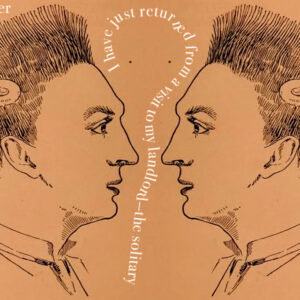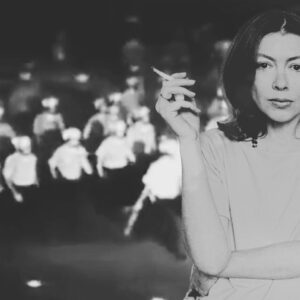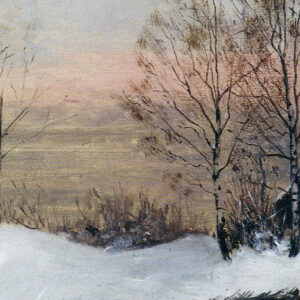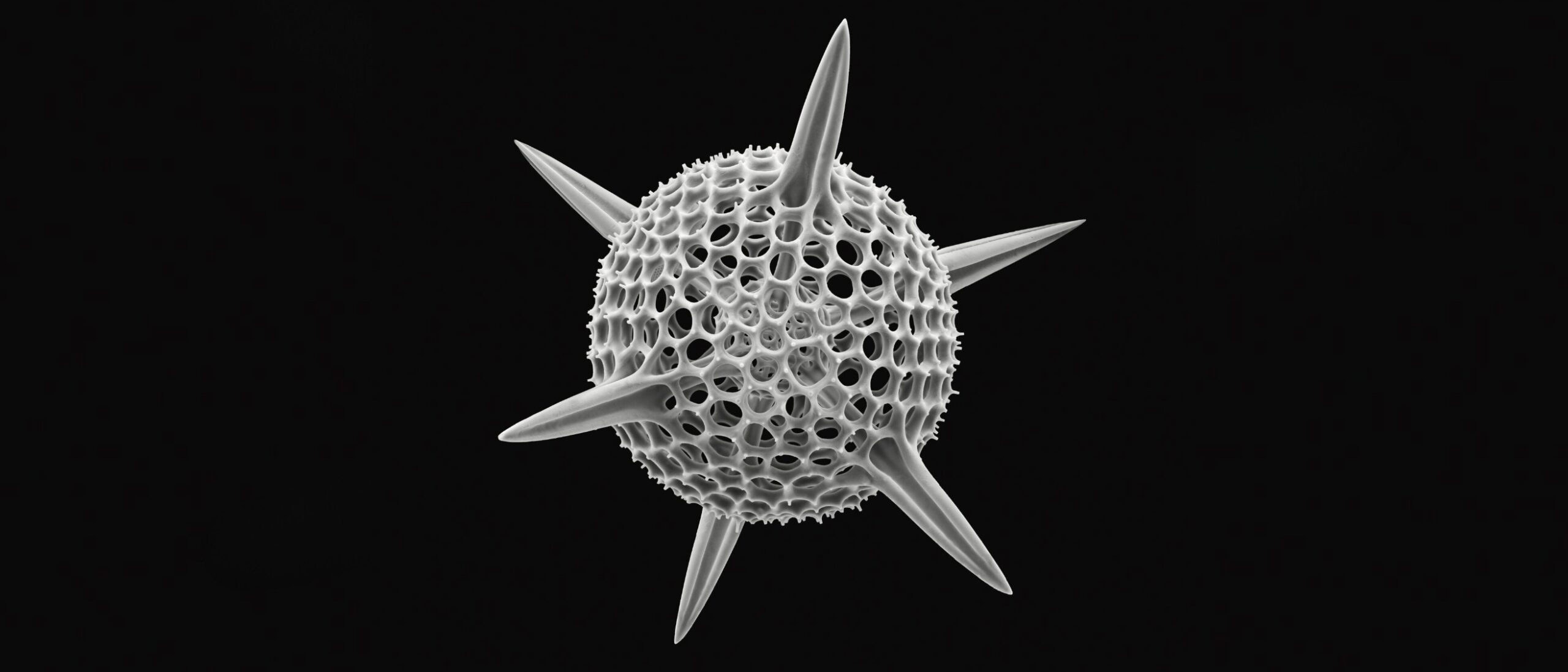
How the Discovery of Single-Celled Marine Organisms Resulted in One of the Most Influential Illustrated Books Ever Published
Michael Benson on Ernst Haeckel’s Precise Drawings of Radiolarians
No creatures from the microscopic world have managed to captivate the human imagination as authoritatively as radiolarians. Since the late nineteenth century, they’ve made their existence known in art, architecture, design, and even literature. These single-celled marine organisms, which appear to have teleported straight from some rarified Euclidean space into all the world’s oceans, seamlessly fuse geometry and biology. Their astonishingly complex glassine skeletons may serve to protect and regulate buoyancy for the cell inside, but they also seem a kind of physical embodiment in sculpted glass of what radiance means.
Radiolarians are adept at distilling silica, a form of quartz, from seawater, a process known as biomineralization. In this process, they generate a kind of mad geometer’s vocabulary of forms—polyhedra, Archimedean solids, icosahedrons, dodecahedrons, and the like—tongue-twisting shapes perforated by radiating spines and microtubules. Their extraordinary morphologies serve to refute any suggestion that biological forms must simplify as they grow smaller.
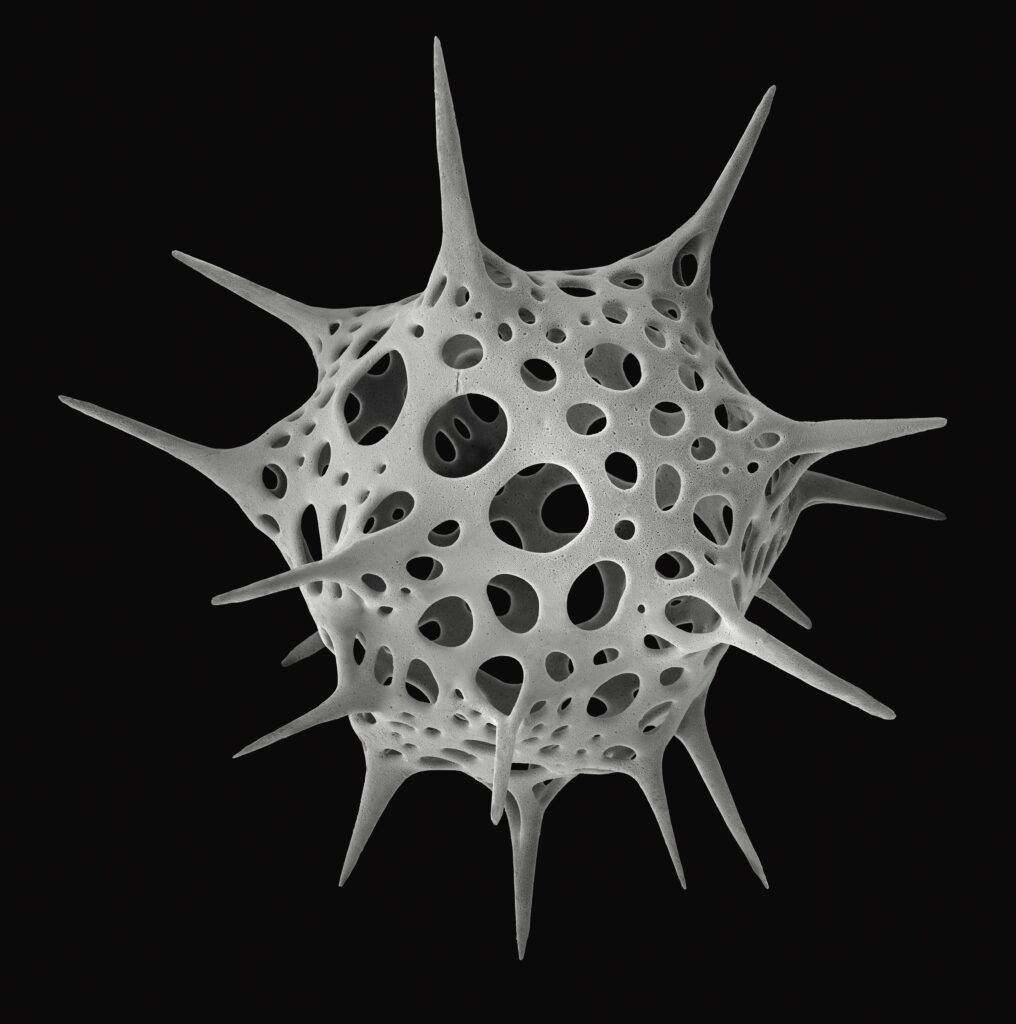 Acrosphaera spinosa fasciculopora radiolarian, Equatorial Pacific
Acrosphaera spinosa fasciculopora radiolarian, Equatorial Pacific1833 x. 120 microns wide, 0.12 of a millimeter. © 2025 Michael Benson.
If anything, the opposite appears to be true. They can be found wherever salt water makes waves, but particularly in the warmer surface layers of the Indian and Pacific Oceans. No single species predominates.
Complexity packaged within geometry is a radiolarian signature.
Radiolarian skeletons are typically constructed of an orderly mesh of rigid polygons. These are frequently shaped into nested spheres—though there are many exceptions, including intricate axial symmetries. The central sphere contains the cell’s endoplasm and nucleus, site of the greatest cellular activity. Surrounding that and protected by an outer shell is the cytoplasm, a frothy liquid of protein-synthesizing ribosomes, energy-producing mitochondria, energy-storing lipids, and the like.
Most radiolarians are heterotrophic, meaning they consume plant and animal matter, but many also possess photosynthetic abilities due to endosymbiosis (in which one organism, the photosynthetic one, lives within the larger radiolarian, to the benefit of both). This allows them to acquire energy from sunlight as well. Their characteristic projecting spines serve both as flotation modulators (via a complex process akin to raising and lowering protoplasmic sails) and as masts permitting the cell to extend itself outward into the surrounding water and feed. Complexity packaged within geometry is a radiolarian signature.
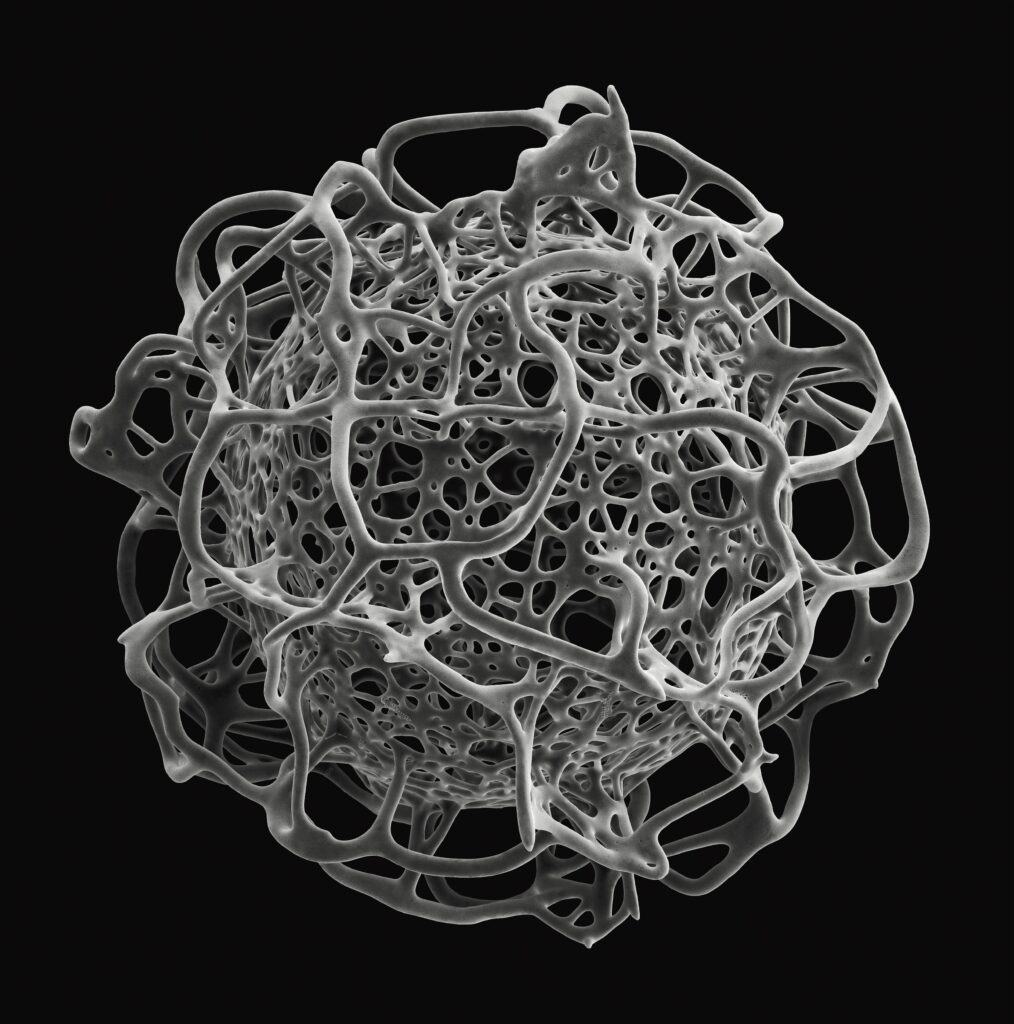 700 x. 300 microns wide, 0.3 millimeter. © 2025 Michael Benson
700 x. 300 microns wide, 0.3 millimeter. © 2025 Michael Benson
For all that, they only live for about two weeks. After which radiolarians sink, producing a steady snowfall of delicate glasswork onto the ocean floor. Depending on the depth, their skeletons can take up to fifty years to descend—a gentle rain continuously falling in all the world’s oceans since at least the Middle Cambrian era, over 500 million years ago. The resulting carpet of fallen forms eventually compounds into a siliceous ooze which, on million-year timescales, eventually yields a particularly dense, fine-grained rock called radiolarite, aka chert or flint.
In this way, one of the first forms of life to have possessed a skeleton of any kind returns to the land. Chert was in turn used by some of the earliest protohumans to make tools and was thus a key material in the 3.4-million-year-long Stone Age. There are many ways to infiltrate human culture.
So how did radiolarians manage to do a bit more of that, in relatively recent history? Therein lies a tale.
In 1859, a young German physician with a newly minted license to practice surgery and obstetrics decided to go on a trip to Italy. Ernst Haeckel had never been entirely convinced that medicine was his calling. He’d gone into the field under parental pressure and had been repelled by the surgical gore of medical school.
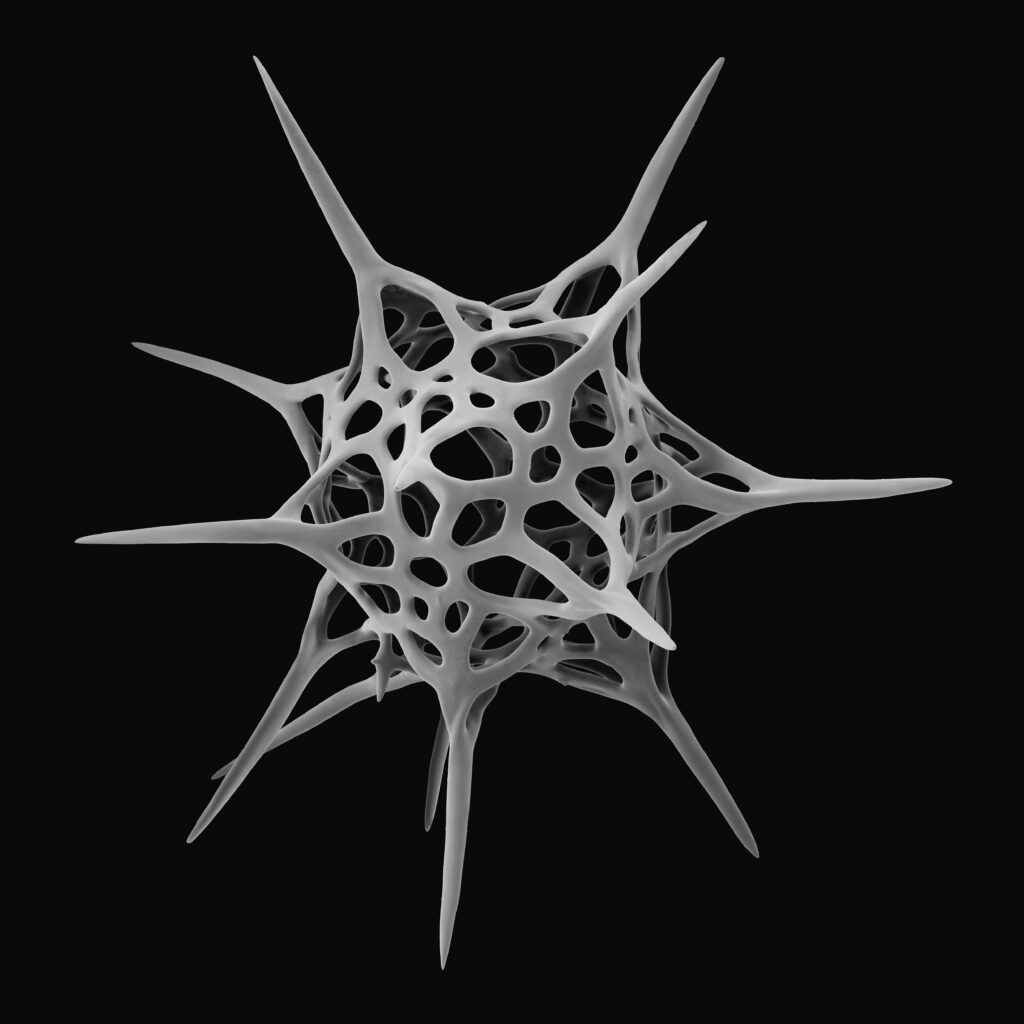 Acrosphaera spinosa fasciculopora radiolarian, equatorial Pacific
Acrosphaera spinosa fasciculopora radiolarian, equatorial Pacific1433 x. About 150 microns across, 0.15 millimeter © 2025 Michael Benson
But Haeckel had a decidedly research-oriented side and had been supported in his interest in the natural sciences by a distinguished professor at the University of Wurzburg, anatomist Albert von Kölliker. Deploying the newest compound microscopes then being produced by Carl Zeiss in nearby Jena, von Kölliker had in effect moved from the dissection table to the lab, thereby founding a new medical field: microscopic anatomy.
Amazed by their radial symmetry and jewel-like skeletons, Haeckel realized that the only way to do radiolarians justice was to draw them with as much precision as possible.
Haeckel’s Italian trip was part of a surreptitious alternate life plan. While visiting a friend at the University of Jena, he had been offered the prospect of an academic career—something he chose to keep confidential. The friend, Carl Gegenbaur, was already a professor at the university. He suggested Italy as an ideal educational destination for young Ernst in preparation for a possible position in Jena.
At the outset of his trip Haeckel was still shaken from the death, probably by suicide, of one of his professors, the esteemed physician and marine biologist Johannes Müller. He was determined to continue research into a type of marine organism, the radiolaria, that Müller had initiated.
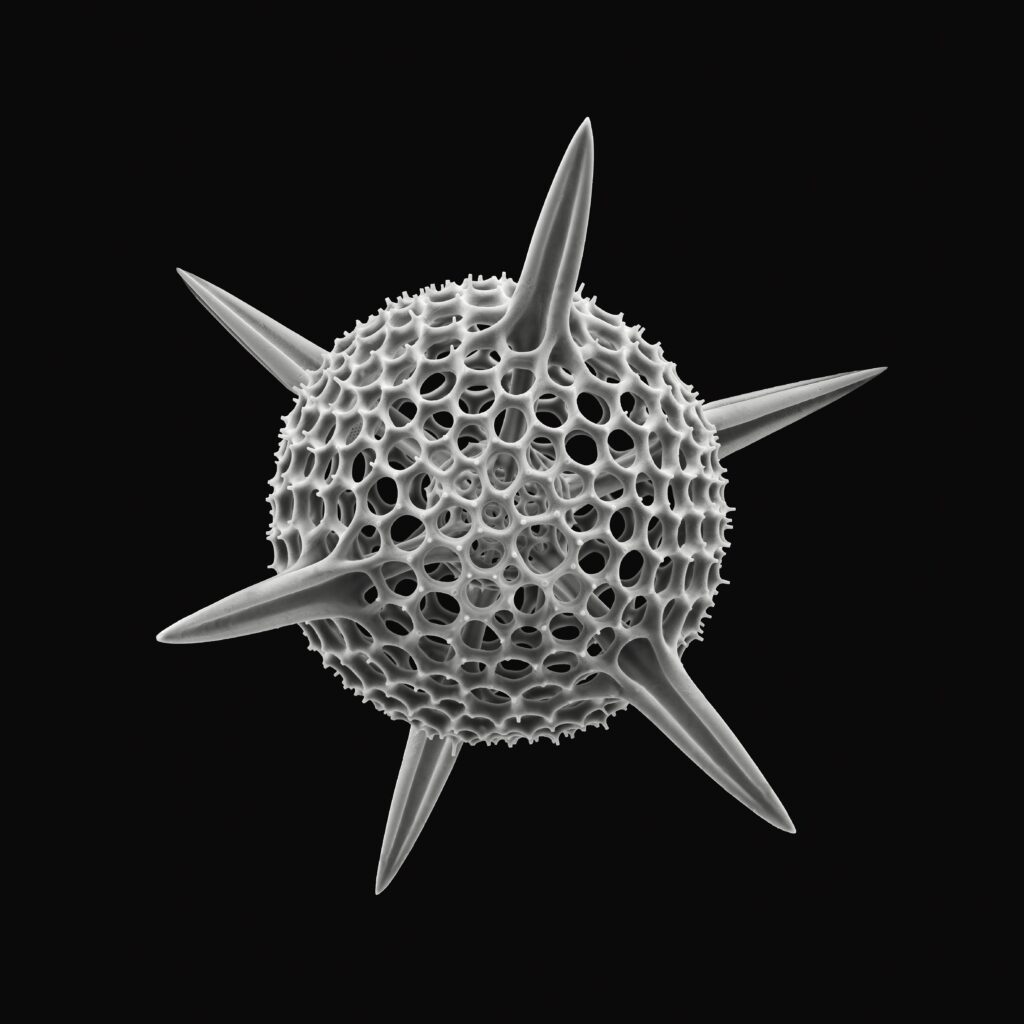 Hexalonche philosophica radiolarian, equatorial Pacific 889 x. 225 microns from tip to tip, 0.2 millimeter © 2025 Michael Benson
Hexalonche philosophica radiolarian, equatorial Pacific 889 x. 225 microns from tip to tip, 0.2 millimeter © 2025 Michael Benson
Considered one of the greatest natural philosophers of the nineteenth century, Müller had been among the first to describe this group of single-celled plankton with intricate skeletal structures. He had also promoted the term radiolarian, a derivative from the Latin radiolus, which referred to their characteristic radiating points. Working primarily in the North Sea, Müller had pioneered the use of extremely fine nets to collect these and other tiny marine organisms.
On an extended trip to Messina, Haeckel set about resuming Müller’s radiolarian work. He commissioned an elderly fisherman in the Sicilian harbor city, Domenico Nina, to row him around while he sieved the sea with nets based on Müller’s design. Examining what he brought back with a growing fascination, he quickly realized that the rich waters of the Strait of Messina—a unique Mediterranean environment where swift currents funnel nutrients through a constricted space—was yielding dozens of previously undiscovered species.
Just as von Kölliker’s use of the microscope in anatomy had created a new field, now the combination of Müller’s nets, Haeckel’s artistic abilities, and a specialized feature of the microscope he had brought from Germany, produced by the Berlin company Schiek, enabled a new chapter in marine biology—one that he had the opportunity to write.
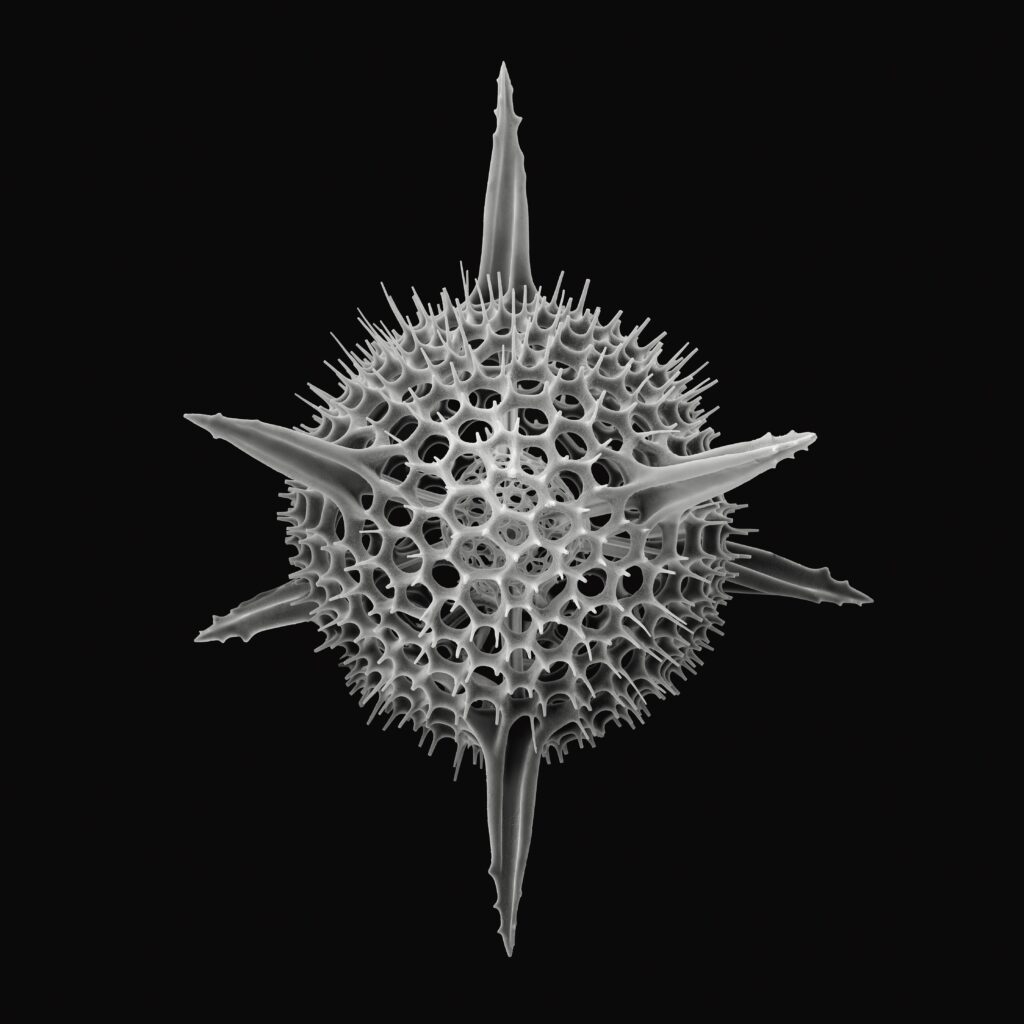 Hexicontum pachydermum, equatorial Pacific. 733 .x 250 microns wide, 0.25 millimeter © 2025 Michael Benson
Hexicontum pachydermum, equatorial Pacific. 733 .x 250 microns wide, 0.25 millimeter © 2025 Michael Benson
Amazed by their radial symmetry and jewel-like skeletons, Haeckel realized that the only way to do radiolarians justice was to draw them with as much precision as possible. To accomplish this, he used his microscope’s camera lucida attachment—an advanced feature which enabled him to project his marine samples directly onto paper, where they could be traced by his pen. The results were unprecedentedly exact renderings.
By early 1860, Haeckel had discovered over a hundred new radiolarian species. In harnessing his artistic abilities to what was clearly a creative scientific drive, he’d also found his calling. By 1862 he had published an illustrated monograph, The Radiolarians, which he dedicated to Johannes Müller. It contained ten sumptuous color plates, with each depicting multiple species in detail.
Ernst Haeckel’s Art Forms in Nature continues to be among the most influential illustrated books ever published.
Nothing quite like it had been seen before, and when Haeckel sent a copy to Charles Darwin, whose On the Origin of Species had been published just three years before, he soon received an enthusiastic response. “It is one of the most magnificent works which I have ever seen, & I am proud to possess a copy from the author,” the great naturalist wrote. “It is very interesting & instructive to study your admirably executed drawings; for I had no idea that animals of such low organization could develop such extremely beautiful structures.”
Having established himself as a marine biologist and initiated a link with the greatest scientist of his time, Haeckel rapidly ascended to international prominence. Successive illustrated monographs on sea sponges, jellyfish, and zoology earned him a full professorship in Jena, and he became the leading proponent of Darwin’s evolutionary theories in Germany.
By the late 1870s, he was asked to take part in the gargantuan task of evaluating and cataloguing the results of the five-year Challenger expedition—an ambitious British global research voyage, the first ever dedicated purely to science. Haeckel’s contribution to the final 50-volume Report of the Voyage of H.M.S. Challenger took a decade to complete and spanned three volumes, 2,750 pages, and 130 plates.
The latter were produced with talented master lithographer Adolf Giltsch, a lifelong collaborator in Jena who possessed “the knowledge-seeking drive of a true naturalist,” as Haeckel put it. In his Challenger work alone, Haeckel described over 4,000 new radiolarian species. He had become by far the leading authority on the subject.
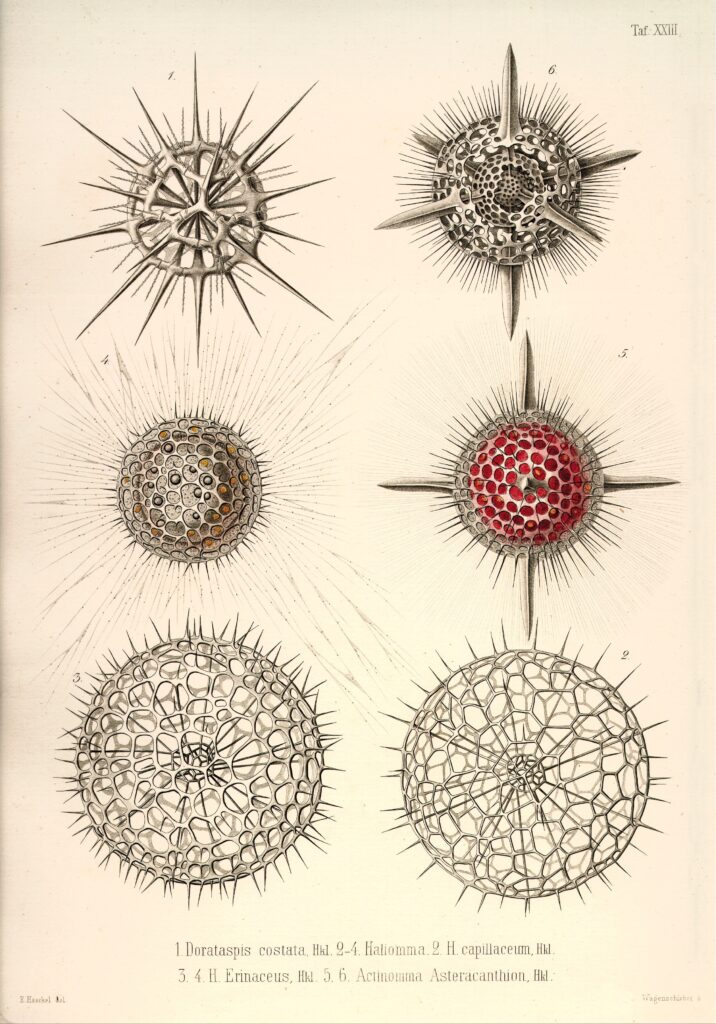
Ernst Haeckel and Adolf Giltsch, Radiolarians, 1887, lithograph.
Smithsonian Libraries and Archives.
By the turn of the century, Ernst Haeckel had amassed enough drawings to produce his great masterpiece and the single work most associated with his name, Kunstformen der Natur (Art Forms in Nature). Once again, Giltsch’s lithographs turned Haeckel’s drawings into finely tuned renderings suitable for mass reproduction. Radiolarians were visible throughout the book, which was published as separate volumes between 1899 and 1904 and finally as a complete edition in 1904 with one hundred full-page lithographs. An immediate commercial success, it has never gone out of print.
As already touched on in the Introduction, Art Forms in Nature almost immediately impacted the visual culture of the early twentieth century. Artists of the art nouveau and German Jugendstil movements channeled Haeckel’s discoveries into their work, as did such leading architects and designers as Antoni Gaudí and Louis Sullivan. In 1898, architect René Binet unveiled his design for the Porte Monumentale, a grand three-legged archway intended to serve as the entrance portal to the upcoming 1900 Paris Exposition. The massive structure was based on the radiolarians that Binet saw in Haeckel’s Challenger plates, a fact which he made clear in letters to the marine biologist, now in his late sixties.
Binet’s Porte was duly constructed late the following year and marked a kind of apotheosis of natural design incorporated within architecture. Comparable in size to the Arc de Triomphe, the Porte Monumentale also contained surface ornamentation based on Haeckel’s exacting lifelong documentation of organisms to be found in the world’s oceans. When the Exposition closed that November, however, it was unceremoniously disassembled, never to be seen again.
By contrast, Ernst Haeckel’s Art Forms in Nature continues to be among the most influential illustrated books ever published. Ranking as the first international image-based arts-science bestseller, it brought the enduring mystery of nature’s extraordinary ability to forge dazzlingly intricate structures to the public.
__________________________________
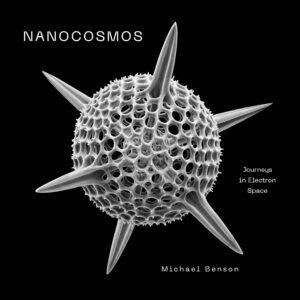
From Nanocosmos: Journeys in Electron Space. Used with the permission of the publisher, Abrams Books. Copyright © 2025 by Michael Benson
Michael Benson
Michael Benson is an artist, writer, and filmmaker who focuses on the intersection of art and science. His highly regarded books include Beyond, Far Out, Planetfall, and Cosmigraphics. He lives in New York City.









